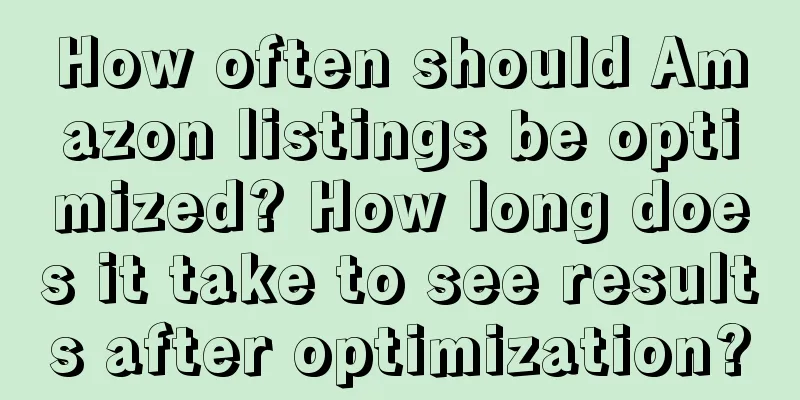How often should Amazon listings be optimized? How long does it take to see results after optimization?

|
On the Amazon platform, optimizing listings is the key to increasing product exposure and sales. However, many sellers are confused about the frequency of optimizing listings, that is, how often do Amazon listings need to be optimized? 1. How often should Amazon listings be optimized? First of all, the competition environment on Amazon is very fierce, with a large number of products being listed and updated every day. Therefore, in order to maintain competitiveness and increase exposure, sellers are advised to optimize their listings regularly. Generally speaking, it is reasonable to fully optimize the listings every three to six months. Secondly, the ranking of products on the Amazon platform is calculated based on multiple indicators such as sales, click-through rate, and reviews. When sellers optimize their listings, these indicators will not immediately reflect the effect. It usually takes some time to see the ranking changes and exposure of the optimized listings in the search results. 2. How long does it take to see results after optimizing your listing on Amazon? After Amazon optimizes the listing, sellers are usually concerned about when the optimization effect will be seen. Although it is impossible to give a specific timeline, generally speaking, it takes some time to see the effect after Amazon optimizes the listing. First, you need to understand how the Amazon search engine works. Amazon's search engine regularly crawls and updates product information and ranks products based on a series of algorithms and metrics. Therefore, after optimizing your listing, you need to wait for the Amazon system to re-crawl and process product information before you can see the effect. Secondly, the effect of optimizing listings is also affected by other factors, such as product competitiveness, market demand, sales strategy, etc. If the seller only makes simple modifications to the listing without making substantial changes, it may take longer to observe the effect. In addition, the characteristics of different products and categories should also be taken into account. Some popular products or highly competitive categories may take longer to show the effect of optimization. However, some low-competition products or niche categories may see the effect in a shorter period of time. Finally, sellers can evaluate the effect of optimization by monitoring changes in key indicators. These indicators include click-through rate, conversion rate, sales volume, and reviews. By tracking changes in these indicators, the effect of optimization can be evaluated in a timely manner, and the listing can be further adjusted and optimized as needed. In short, it takes some time to see the effect after Amazon optimizes the listing. Sellers can evaluate the frequency of optimization based on product characteristics, competitive environment and market demand, and judge the effect of optimization by changes in key indicators. |
>>: What happens if Amazon credit card charge fails? Where can I view the charge?
Recommend
How to get Amazon SKU code? How to apply?
Some of Amazon's products have many specificat...
Why am I not optimistic about Xiaohongshu’s local life?
Xiaohongshu has recently entered the local life tr...
Can Wish deliver goods locally? How does Wish deliver goods?
Some of the merchants who have opened stores on th...
Taobao 88VIP major upgrade, will it compete head-on with JD.com PLUS members?
As paying members, who is better this year? Every ...
Does shein need an overseas warehouse to open a store? What is shein?
More and more merchants are opening stores on shei...
2024 Tik Tok Advanced Brief & Explosive Talk!
In 2024, the functions and gameplay of TikTok are ...
A copywriter’s self-cultivation!
We both hate and love copywriting. Good copywritin...
How does NIO, the "Haidilao" of the car industry, conduct private domain marketing?
In the current fierce competition in the automobil...
What is the credit status of an Amazon account? What should I do if my credit status is bad?
On Amazon, the world's largest e-commerce plat...
How is Shopee's cross-border e-commerce? How to join Shopee?
With the development of cross-border e-commerce, m...
Shopee Advertising Incentive Program for January 2023
Shopee's January 2023 advertising incentive pl...
After the price leveling, a new round of secret war among e-commerce platforms has begun
The price war among e-commerce platforms seems to ...
What are the things to pay attention to when selling clothes in Shopee?
As one of the largest food delivery e-commerce pla...
What does an Amazon packing slip mean? What are the requirements?
Amazon's cross-border e-commerce platform is d...
Fang Wenshan talked about how to write advertisements
Music has the power to touch the soul. Vincent Fan...









